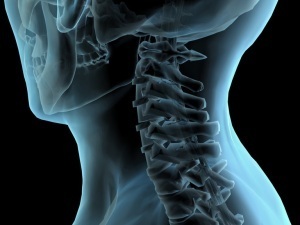Signs of cervical osteochondrosis in a strong manifestation usually surprise the patient, although the preconditions for the disease are observed long before the onset of the main symptoms and are the result of degenerative changes in the structure of the spine. The nerve roots of levels C5, C6, C7 (cervical spine) are most often affected.
Clinical manifestations
Symptoms of cervical osteochondrosis are divided into radicular and reflex.
Reflex Syndrome

Lumbago is characteristic of reflex symptoms. Their main feature is the sudden appearance of an awkward movement, twitching or prolonged presence of the head in one position. Lumbago of the cervical spine literally throws a person out of the rut, movements become limited, the patient takes a forced position due to severe pain.
Frequent patient complaints:
- narrowing headaches radiating to the temples or eyeballs;
- she reduced her visual acuity, before her eyes as if "everything is floating";
- possible increase in pressure.
Spinal artery syndrome occurs when the nerve plexus is irritated, which is often misdiagnosed as a cerebrovascular accident. Manifestations of cervical osteochondrosis with a similar syndrome are frequent dizziness that occurs with a sharp turn of the head, almost always accompanied by an unpleasant feeling of nausea and even vomiting.
It is important to exclude cerebrovascular accidents when making a diagnosis, because the treatment of osteochondrosis differs significantly from the treatment of diseases of the vascular system.
With the cardiac symptom in the clinic of reflex syndromes in cervical osteochondrosis, the patient is characterized by feelings resembling an attack of angina pectoris, but usually no difficulty in accurately diagnosing the disease, because the cardiac symptom is accompanied by numerous symptoms characteristic of osteochondrosis.
Radicular syndrome
Signs of cervical osteochondrosis in radicular syndrome occur in direct proportion to the "number" of compressed nerve.
Symptoms, sensory and motor changes depend on which nerve root is affected:
- C1- there is a violation of sensitivity in the occipital region;
- C2- the patient feels pain in the parietal and occipital region;
- C3- pain occurs in the middle of the neck where the injury occurred. Symptoms: decreased sensitivity, impaired work and touch of the tongue, speech disorders;
- C4- there is pain in the shoulder-scapular region, impaired sensitivity, may hurt the heart and liver;
- C5- the patient does not feel good shoulder on the outer surface, he is worried about pain in this area;
- C6- pain in osteochondrosis at the level of the 6th vertebra extends to the forearm, shoulder blade, radial surface and "descends" to the thumb of the hand;
- C7- the pain "spreads" from the neck to the shoulder blade, passes along the back of the shoulder and forearm, goes to 2-4 fingers of the hand, the sensitivity in this area worsens;
- C8- pains are localized from the neck to the shoulders and further to the little finger.
Unbreakable pathological connection

VSD and cervical osteochondrosis are closely related, and vegetative-vascular dystonia can manifest as a result of damage to the cartilage of the cervical joint, which weakens the human nervous system. Dystonia and osteochondrosis, detected at the same time, can be a common disease or VSD occurs for common reasons.
Osteochondrosis is one of the factors that provokes VSD, but it is not necessary for the latter to follow from the former.
Vegetative-vascular dystonia is often manifested in various types of osteochondrosis, especially in disorders of the cervical spine. But it can also manifest as a result of injury, there is compression of the nerves in the cervical spine, blood flow deteriorates and the pressure inside the skull increases.
Diagnostic Errors
VSD, osteochondrosis and pain in the thoracic region are treated fundamentally differently. Expensive (and often unnecessary) tests show nothing but problems in the cervicothoracic region and vascular disorders. In this case, the treatment often remains the same - heart complexes, vitamins, antidepressants. Chiropractors remove the pain, put the patient in an optimistic mood, but panic attacks, stress and fatigue do not go anywhere.
More and more people are victims of improper therapy, panic attacks (or VSD attacks) are becoming almost the norm, but still, many patients prefer self-medication or visits to "doctors" whose activities are not aimed at resolving the disease, alisamo forjust enrichment.
Groups of characteristic manifestations
The main clinical signs of cervical osteochondrosis can be divided into several groups:

- first.Neurological symptoms occur as a result of complications of cervical osteochondrosis and direct pressure on the nerve roots, nerve plexuses;
- seconds.Symptoms are manifested by direct exposure to the spinal cord;
- third.Symptoms occur in the brain and affect its vessels, structures, membranes and trunk.
Each of these groups has its own clinical signs and pattern of manifestations, but there is a commonality of symptoms, thanks to which it is possible to make a correct diagnosis.
Symptoms of osteochondrosis of the cervical spine often appear as a neurological complication, characterized by pain in the shoulder joint. This pathology is called “shoulder blade periarthritis”.
Characteristic compressions of the spinal cord in the cervical region are volumetric lesions in the tissues and a strong reduction in important functions. Sensitivity of the skin and muscles is impaired, paresis develops, and in complex pathological cases paralysis.
Therefore, even at the first suspicion of cervical osteochondrosis, it is important to visit a specialist, carry out the necessary diagnostic measures and undergo a course of treatment. Remember that pathology detected in time is removed quickly and without consequences.


































